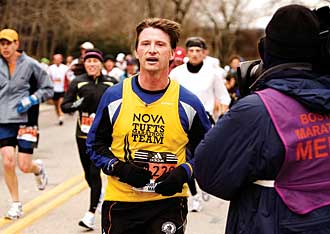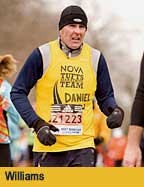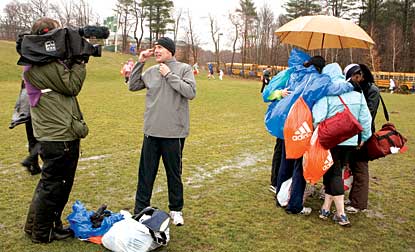


Nova had a dozen HD cameras at the Boston Marathon, watching its own team of yellow-clad runners. Pictured: Presidential cousin Jonathan Bush. (Photo: Joel Laino for Nova.)
Marathon drama comes with physiological surprises
Originally published in Current, June 11, 2007
By Audrey Grayson
If you had seen Daniel Williams only nine months before he crossed the Boston Marathon finish line, you probably wouldn’t have expected him to enter such a grueling race, much less run all 26.2 miles.
“I was definitely one of those people who thought they could never run a marathon, but I think when people see the success I had in training for this, it will challenge a lot of their beliefs about the ability of an average person to go from relatively inactive to marathon-runner,” Williams said.
 Williams, a 39-year-old college administrator, was one of the 13 inexperienced runners handpicked by producers of the upcoming Nova documentary “Marathon” to train for the April 16 Boston Marathon through the Tufts University President’s Marathon Challenge, a prestigious training program for first-time marathoners.
Williams, a 39-year-old college administrator, was one of the 13 inexperienced runners handpicked by producers of the upcoming Nova documentary “Marathon” to train for the April 16 Boston Marathon through the Tufts University President’s Marathon Challenge, a prestigious training program for first-time marathoners.
The producers cast Williams and a dozen other sedentary people of different ages, body types, backgrounds and medical histories to demonstrate the body’s surprising adaptability. Among the runners was Jonathan S. Bush, a first cousin of President George W. Bush. Cameras followed Team Nova members through nine months of training, medical exams and interviews to capture the physical and emotional effects of all that exercise.
The Nova episode, scheduled by PBS for Oct. 30, not only presents a curriculum of past scientific findings but also may add some unanticipated results from what became an on-camera mini-study in exercise physiology.
“Part of what we’re dealing with at this point,” said episode producer Hillary Wells, “is that the expectations of what we were going to say [in ‘Marathon’] didn’t play out the way we thought they would.”
Nova producers hatched the idea for “Marathon” approximately three years ago to teach people “about issues that are very much a concern to them—like weight loss, cholesterol, heart disease and wellness—through some very interesting and important human stories,” said Paula Apsell, senior executive producer of the series and director of the WGBH Science Unit.
To pull off the experiment in the midst an enormous road race required collaboration with the marathon’s sponsor, the Boston Athletic Association. The association, which ordinarily keeps photographers off the course, gave Nova unprecedented access.
Starting out, the other team members were as inactive as Williams or worse, he said. “One runner was recovering from a surgery to remove tumors,” he said. “. . . Others had something in their religious belief systems that made their training a challenge.”
Team Nova had elite coaching and training guidance from Tufts Marathon Challenge Coach Don Megerle, nutrition scientist and author Miriam Nelson and three-time Boston Marathon winner Uta Pippig. Exercise and nutrition specialists at the university monitored the participants’ physiological transformations during training.
“This is a little experiment by itself, in the sense that we tested the runners before . . . and after they had run the marathon,” Apsell explained. “We actually did find some very interesting changes that took place within the body, so in some sense this is our own proof, individual proof, that exercise can have [an] effect. . . . I think this will question, if not quite overturn, some of the established notions about the impact of exercise on the body and what happens to the body while you’re running.”
The film supports recent research that contradicts the conventional wisdom about exercise on several points. Lactic acid, for instance, is no longer believed to be the wholly negative force that’s widely blamed for muscle fatigue.
It was not an easy shoot, even during the months of training.
“People don’t film running sequences too often because it’s hard,” said director Dan McCabe, “but on top of that we wanted to talk to people, even as they were running. We had to try a lot of different contraptions.”
McCabe’s favorite camera platforms were the electric golf carts that the crew used for every Sunday run, but the race sponsor objected that the carts would be too big to be used on Marathon Monday. For the race, Nova put its cameras on three tiny Honda Ruckus scooters, with rear-facing seats added for camera operators. At the finish line, a Nova camera operator rode the motorcycle used for live coverage of the winners earlier in the day.

Out of shape a few months ago, a dozen Team Nova runners were ready to race on Marathon Monday. Pictured: pre-race huddle in the rain.
The program’s workforce and costs peaked on the day of the marathon with 50 crew members and volunteers and 12 cameras, mostly Panasonic high-definition VariCams, supplemented by a few lower-cost HDV camcorders.
Because narrow stretches of the course often become congested with runners, each camera operator on a scooter could capture only a few of Team Nova’s runners. The runners in the most crowded time divisions, including Williams, were filmed as they passed stationary cameras; they narrated the experience into three-ounce Roland Edirol MP3 recorders hanging from their belts.
Nova producers don’t want to discuss any surprises in the story line or reveal how many Team Nova runners finished the race, but all but one of the 13 were ready for the marathon and a number of others finished.
That may support the controversial views of Daniel Lieberman, a Harvard professor of biological anthropology and a commentator in the film. Lieberman contends that humans adapt readily to endurance running because, back in Mother Africa, their distant ancestors evolved to have an amazing ability to run long distances in pursuit of four-legged dinners, despite the heat that slowed their prey.
Some of Team Nova’s bodies did indeed adapt to the demands of training.
Despite the film’s elaborate logistics, Apsell said she has no regrets that the runners, and the producers as well, went so far to demonstrate dramatically what the human body can do when pushed.
“This is not easy for anyone. Everyone had to joust with their own personal demons to make this happen, and that’s going be the most important thing about this [documentary],” Apsell said. “A lot of viewers will walk away from this very inspired, as I am.”
Audrey Grayson is a freelance writer in Boston and a recent graduate of Boston University.
Web page posted June 11, 2007
Copyright 2007 by Current Publishing Committee